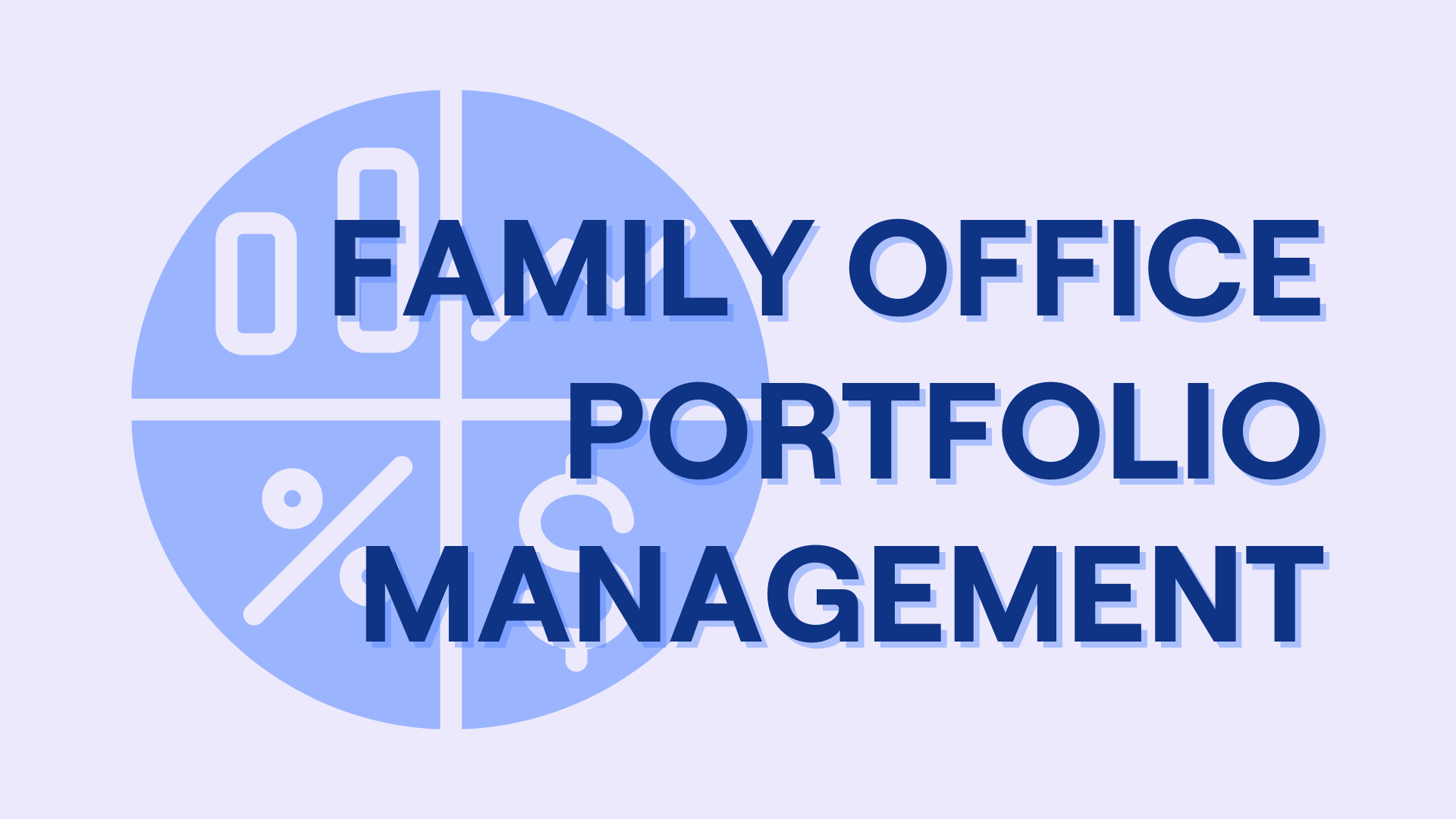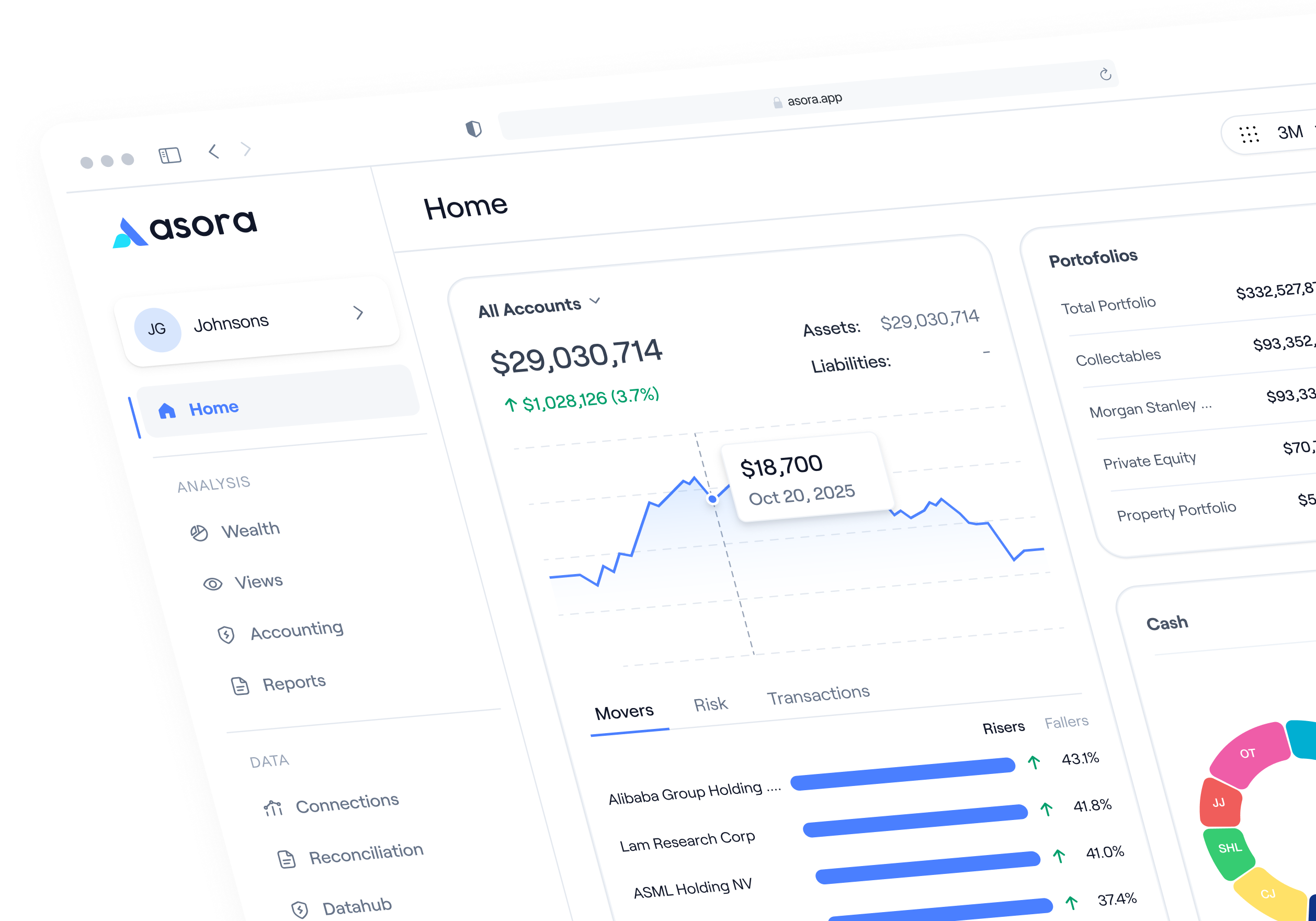Automate your family office
Schedule DemoHeading 1
Heading 2
Heading 3
Heading 4
Heading 5
Heading 6
Lorem ipsum dolor sit amet, consectetur adipiscing elit, sed do eiusmod tempor incididunt ut labore et dolore magna aliqua. Ut enim ad minim veniam, quis nostrud exercitation ullamco laboris nisi ut aliquip ex ea commodo consequat. Duis aute irure dolor in reprehenderit in voluptate velit esse cillum dolore eu fugiat nulla pariatur.
Block quote
Ordered list
- Item 1
- Item 2
- Item 3
Unordered list
- Item A
- Item B
- Item C
Bold text
Emphasis
Superscript
Subscript
TL;DR
Effective reporting underpins transparent governance and timely decisions in family offices. The most valuable reports are accurate, current, and tailored to the questions principals and advisors actually need answered. This guide outlines seven practical practices that enhance clarity, consistency, and traceability back to the source data, enabling stakeholders to act with confidence rather than sift through noise. Apply these practices to reduce reporting cycle time, cut errors, and elevate the quality of reviews and conversations.
Introduction
Family offices operate with high stakes. Principals depend on clear visibility, advisors need reliable data to guide recommendations, and finance and operations teams require consistent, auditable information. Too often, reports arrive late, overwhelm readers with excessive detail, or fail to address the questions that matter. Strong reporting delivers the correct information to the right people at the right time, in a format that supports confident decisions. The seven practices that follow focus on outcomes: clarity over volume, consistency over one-offs, and verifiable links to the underlying data.
Best Practices for Better Family Office Reports
1. Build a Clear and Consistent Reporting Framework
Consistency is everything in family office reports. When the format changes every quarter, when KPIs shift without explanation, when data is presented differently depending on who creates the report, it creates confusion instead of clarity.
Start by establishing a standardized reporting framework that everyone understands:
- Define the core KPIs: Pick the metrics that actually matter for tracking progress toward family goals.
- Create consistent formats: Use the same structure, visual style, and terminology across all reports. When family members know where to find information, they're more likely to engage with it.
- Document your methodology: Specify how performance is calculated, how private assets are valued, and which benchmarks are applied. Publish the rules, apply them consistently, and ensure they are transparent and auditable. Methodologies should evolve as portfolios or data sources change, and updates must be clearly documented to maintain comparability.
A well-defined framework means everyone involved (family, advisors, the family office team) can make meaningful comparisons over time. They understand what changed and why, rather than wondering if the numbers shifted due to actual portfolio movements or simply different calculation methods.
2. Deliver Reports Regularly and On Time
Markets move, opportunities emerge, and risks evolve. If the report arrives two weeks after the month-end, decisions are made on stale information.
Commit to a realistic reporting schedule and stick to it:
- Monthly for active portfolios: If the family office invests actively, monthly reporting provides the chief investment officer with visibility needed for timely decisions.
- Quarterly for more stable situations: Less active portfolios might not need monthly detail, but quarterly reporting keeps everyone informed of trends and changes.
- Annual for comprehensive reviews: Deep-dive annual reports that look at long-term performance, tax planning, and strategic adjustments.
Building trust means delivering on commitments. Family members and professional investors should know exactly when to expect reports and trust that they'll arrive on schedule. Automated reporting tools make this infinitely easier than manual processes that always seem to run late.
3. Tailor Reports to Individual Needs
Family offices worldwide often make the mistake of creating a single, comprehensive report and sending it to everyone. The principal, the kids, the trustees, and the advisors are all getting the same document.But different stakeholders need different information:
- The principal wants high-level visibility into total net worth, overall performance, major decisions that need attention, and progress toward long-term goals.
- Next-generation family members may need an educational context alongside their numbers, helping them understand investment strategies, succession planning, and valuable insights into why certain decisions were made.
- The investment committee needs detailed performance attribution, cost savings, risk metrics, investment trends, manager evaluations, and portfolio analytics.
- Trustees and advisors require specific information relevant to their fiduciary responsibilities or sophisticated investor roles.
- The accounting team needs transaction-level detail for reconciliation and tax planning.
One size doesn't fit all. Remember, these are reports and shouldn't require interested parties to undertake a comprehensive study to obtain the necessary information.
Effective family office reports are customized to what each recipient actually needs to know and can act on. This doesn't mean creating entirely separate reports from scratch. Instead, it means having flexible reporting tools that can present the same underlying data in various views tailored to different audiences.
4. Leverage Technology for Better Reporting
Preparing reports manually in Excel and PowerPoint is labor-intensive and raises the likelihood of errors.Family office operations need technology that streamlines the entire reporting process:
- Automated data aggregation: Pull information directly from custodians, banks, and investment management services instead of copying it manually.
- On-demand dashboards: Provide stakeholders with current, consolidated views that update according to each data source’s refresh cycle (typically daily or close of business for custodians), not just when a formal report is published.
- Template-based report generation: Create professional reports in minutes instead of days by leveraging templates with automated data population.
- Exception alerts: Flag unusual movements, reconciliation issues, changes in fixed income, or essential events automatically, so nothing falls through the cracks.
Modern family office software automates much of the data process but still requires human oversight for validation, allowing you to focus on analysis, insights, and other advisory services rather than data management and manipulation.
5. Guarantee Transparency and Accessibility
Reports parked in inboxes do not create value, and information locked in inaccessible formats does not support decision-making.
Make family office reporting transparent and accessible:
- Clear presentation: Use plain language, not jargon. Explain what metrics mean and why they matter. Include context that helps readers understand the story behind the numbers.
- Multiple access methods: Some family members want detailed PDFs. Others prefer logging into a dashboard on their phone. Provide options that match how people actually consume information.
- Open communication: Encourage questions. Be available to discuss what the numbers mean and what actions they suggest.
- Appropriate detail: Senior family members may want to see every transaction detail. Younger generations may require summaries that facilitate deeper exploration if they are interested. Match detail level to recipient needs.
Transparency builds trust. When families can access their financial information and understand what they're seeing, they engage more meaningfully in wealth management decisions.
6. Provide Comprehensive Risk and Performance Reporting
Numbers without context are just numbers. Effective family office reports convey the story of how family wealth is performing and highlight the risks that require attention.
Your performance reporting should include:
- Time-weighted returns across relevant periods (monthly, quarterly, annual, since inception) for accurate performance tracking.
- Benchmark comparisons showing how returns stack up against relevant indices and peer portfolios.
- Attribution analysis explaining what drove performance: which asset classes, hedge funds, managers, or strategies added or detracted value.
- Portfolio allocation showing current positioning versus targets, highlighting rebalancing needs. It alerts you when you should adjust or increase allocations.
Risk reporting matters, too:
- Concentration risk: Is your asset management over-exposed to specific sectors, geographies, or asset classes?
- Liquidity analysis: How much can be accessed quickly from a central bank if needed? Where are the illiquid positions?
- Market sensitivity: How might the portfolio perform under different market scenarios?
- Currency exposure: For families with global investment businesses, what's the currency risk profile?
Comprehensive reporting helps families understand what happened, why it happened, and what might happen next. That's the foundation for proactive wealth management, rather than reactive crisis response.
7. Adapt to Evolving Family Needs
Family circumstances change. The global family office report that worked perfectly five years ago might be completely wrong today.
Stay proactive about aligning reporting with current priorities:
- Life transitions: Marriage, divorce, births, and deaths all change what information matters and who needs to see it.
- Generational shifts: As younger family members take more active roles, reporting needs to educate and engage them differently than it did their parents. Explain certain jurisdictions, regulated activities, actions that are strictly prohibited, and where they can find further information.
- Changing investment strategies: Transitioning into private equity, venture capital, or alternative investments necessitates distinct reporting approaches compared to traditional stock and bond portfolios.
- New regulatory requirements: Changes in tax law, new jurisdictions, or evolving compliance obligations may necessitate adjustments to reporting.
Schedule regular check-ins (at least annually) to review whether your family office reports still serve their intended purpose. Ask family members what works and what doesn't. Be willing to evolve.
The Benefits of Great Family Office Reporting
When these best practices are implemented, reporting changes from administrative burden to strategic asset
- aster, better decisions: Family members and advisors have the information they need when they need it, enabling timely action on opportunities and investment risks.
- Improved trust: Consistent, transparent reporting builds confidence in how wealth is being managed. Everyone has the same reliable indicators.
- Reduced errors: Automated processes with validation checks catch mistakes before they make it into reports.
- Better collaboration: When everyone works from the same accurate information, coordination between family members, advisors, and the family office team improves dramatically. Opinions expressed start to align with the year's report (instead of rumors).
- Strategic focus: Less time creating reports means more time analyzing trends, identifying opportunities, and planning for the future.
How to Provide Investment Context (the Right Way)
Strong family office reports pair current figures with the context needed to evaluate investment decisions.
Reports should clearly show what families invested initially in each position versus current values, making gains and losses immediately apparent. Comparing your family's average net worth growth against benchmarks from participating families in similar wealth tiers helps assess whether your investment strategies are competitive.
Include analysis of investment opportunities pursued and those declined to help families learn from both decisions. Track performance across the broad range of asset classes and financial products in the portfolio, from traditional equities to alternative investments.
Remember that past performance doesn't predict future results, but it does inform better decision-making. Whether working with advisory services, active management strategies, or passive approaches, historical context helps professional clients and individual investors alike understand what's working and what needs adjustment.
Move Forward with Better Reporting
The difference between adequate and excellent family office reporting often comes down to the systems and tools used. The key takeaways we've covered aren't particularly complicated (or revolutionary), but implementing them consistently requires the proper infrastructure.
Manual processes will always be slower, more prone to errors, and more difficult to customize than automated solutions. Legacy systems that weren't designed for modern wealth management create friction instead of enabling excellence.
Asora was built to support these best practices. The platform centralizes data from custodians, banks, and administrators, providing on-demand dashboards alongside reports. It supports configurable views aligned to defined permission scopes and strengthens accuracy through validation before reporting.
Schedule a demo and bring your current reporting challenges with you.
FAQ
How often should family offices generate reports?
Most single family offices with active portfolios benefit from monthly reports for timely visibility, while quarterly reports work well for stable portfolios. Annual reports should examine long-term trends and tax implications. Many offices now supplement scheduled reports with on-demand dashboards that family members can access at any time.
What key metrics should every family office report include?
Metrics include total net worth, time-weighted returns, asset allocation versus targets, liquidity analysis, and realized/unrealized gains for tax planning. Risk metrics, such as concentration, currency exposure, and leverage ratios, also play a significant role. Customize KPIs to what actually drives decision-making for your specific family.
How can family offices improve reporting accuracy?
Start by automating data aggregation from custodians and banks to eliminate manual transcription errors. Implement automated reconciliation that flags discrepancies before they reach reports. Technology platforms designed for US family offices include built-in accuracy features that dramatically reduce errors compared to manual Excel processes.
Should family office reports be standardized or customized?
Both. Maintain standardized data collection and calculation methodologies for consistency, but customize presentation and detail level for different recipients. Modern family office software enables you to maintain a single underlying dataset while generating multiple tailored views for principals, investment committees, and trustees.
How is family office reporting evolving in 2025?
The shift is toward timely access over static documents. Family members expect on-demand visibility rather than waiting for monthly PDFs. Automation is replacing manual report creation, with platforms generating reports in minutes instead of days.





.png)






